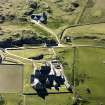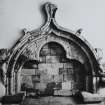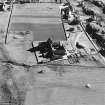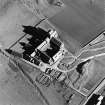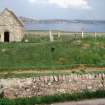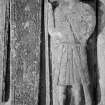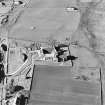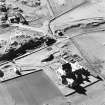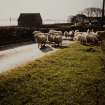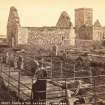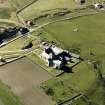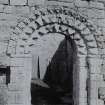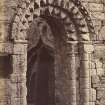Iona, St Oran's Chapel And Reilig Odhrain Burial Ground
Burial Ground (Medieval), Chapel (Medieval), Cross Slab (Early Medieval), Well (Period Unassigned)
Site Name Iona, St Oran's Chapel And Reilig Odhrain Burial Ground
Classification Burial Ground (Medieval), Chapel (Medieval), Cross Slab (Early Medieval), Well (Period Unassigned)
Alternative Name(s) Releig Odhrain
Canmore ID 21617
Site Number NM22SE 10
NGR NM 28589 24451
Datum OSGB36 - NGR
Permalink http://canmore.org.uk/site/21617
First 100 images shown. See the Collections panel (below) for a link to all digital images.
- Council Argyll And Bute
- Parish Kilfinichen And Kilvickeon
- Former Region Strathclyde
- Former District Argyll And Bute
- Former County Argyll
NM22SE 10 28589 24451.
(NM 2857 2443) Reilig Orain (NR) St Oran's Chapel (NR) (In Ruins) Tombs of the Kings (NR)
OS 25" map, (1900)
NM22SE 10.01 2857 2443 Crosses; Cross-Slabs
St Oran's Chapel standing in its burial ground, Reilig Orain - "Oran's Burial Ground", Oran having been a relative and follower of Columba.
The chapel is a plain oblong building measuring 30' by 16' internally. The body of the chapel may belong to the 9th or 10th century's but the west doorway is an insertion which dates from not earlier than the mid-12th century. None of these dates supports the tradition the Queen Margaret (d 1093) built the chapel. An elaborate monument, probably of late date, has been inserted in the south wall of the interior, and a number of monumental slabs are preserved in the chapel, the roof of which has been restored.
Kenneth MacAlpin was buried in the Reilig Orain in the mid-9th century, as were succeeding Scottish kings until Macbeth (d 1057) and traditionally kings of Ireland, Norway and France. None of the monuments of the kings remains but many of medieval clan chiefs survive.
The probable original wall of the graveyard is now below ground level, but has been found by excavation. Two railed enclosures - "The Ridge or Tombs of the Kings" and, to the east of it, that of the Chiefs - have existed only since 1868 when the Iona Club collected the monuments and enclosed them for protection.
The oldest stone now surviving in the graveyard is that which protrudes eastward from the row of slabs in the Ridge of the Kings. It is a pink granite slab bearing a simple, incised, Celtic cross of the 8th or 9th centuries. Two posts of a corner-post shrine were found in 1957.
"Tobar Odhrain" - Oran's Well - now only a site, lay in the area NM 286 243 (Ritchie and Ritchie 1934) (But see also NM22SE 37)
A C Thomas 1957; 1959; W Reeves 1857; D MacGibbon and T Ross 1896-7;
A Ritchie and E Ritchie 1934; R Reece nd.
The chapel and burial ground are as described. The incised Celtic cross lies at NM 2856 2441. No trace of the well could be found. The well at NM 2839 2369 is stone-lined, but no name for it is known.
Visited by OS (R D) 9 June 1972.
NM 2856 2446 A short period of archaeological monitoring was undertaken at Iona Abbey in February 2006 during the excavation of foundation trenches and postholes as part of works on the vehicular and pedestrian entrances into the Abbey grounds. In addition, the pedestrian entrance was to be widened to allow wheelchair access. The areas of work had clearly been subject to modern disturbance, such as the installation of services and the hard standing for the ticket office. Little of the work carried out encroached on undisturbed ground, therefore minimising the potential impact on any underlying archaeology. No features or finds of archaeological significance were found during these works.
Archive to be deposited in NMRS.
Sponsor: Historic Scotland
Claire Shaw, 2006.
Iona, St Oran's Chapel.
IG Lindsay Coll, W/298.
Aerial Photography (April 1969)
Oblique aerial photographs of sites and monuments on Iona, Argyll, photographed by John Dewar in 1969.
Field Visit (June 1980)
St Oran's Chapel and Reilig Odhráin, Iona
This chapel, which is situated towards the N end of Reilig Odhráin, the principal burial-ground of Iona, dates from the 12th century. In the later Middle Ages it served as the burial-place of the MacDonald Lords of the Isles, patrons of the adjacent Abbey and of the chaplainry. After standing roofless but otherwise intact for over three centuries it was restored under the direction of Ian G Lindsay in 1957.
The building measures 9m by 4·8m within walls varying in thickness from 0·7m to 0·9m, and is orientated some 23 degrees S of E. The rubble masonry of its walls, less regular than that used in the Abbey, is composed mainly of local Torridonian flagstone and granite boulders. Yellow-grey sandstone, probably quarried in the Carsaig area of Mull, is employed for dressings and quoins, and numerous roughly squared blocks of the same material are incorporated in the upper part of the w wall. The original freestone of the SW and SE angles, which had been extensively robbed, was replaced by granite quoins in 1855-6. The existing plastered and whitewashed treatment of the interior replaces the wall-plaster, presumably of medieval date, that is visible in early photographs. The roofing-slates used in the restoration were quarried at Cuan, near Cullipool on the Isle of Luing.
The burial-ground now measures about 46m from N to s by 45m transversely at the sand 50m at the N end. Comparison with early plans and photographs shows that until 1875 it was almost rectangular; the NW angle of the enclosure was then moved about 11m, and the SW angle about 7 m to the W, the W boundary having previously been defined by a stone wall traversing the summit of a small rock-outcrop. Dean Monro, writing in 1549, drew particular attention to the 'fair Kirkzaird, well biggit about with stane and lyme'; even in its pre-1875 form, however, the rectilinear enclosure is unlikely to be older than the 1750s, when new walls were built round the ecclesiastical buildings on the instructions of the 3rd Duke of Argyll. The earlier boundary is perpetuated by the curving section of wall N of St Oran's Chapel, known from excavation to lie at the s edge of a major ditch of 6th- or 7th-century date. Although described by an Irish Franciscan in 1625 as 'vast in extent', the area employed for burials at this period was probably similar to that of the modern enclosure, but perhaps extended further to the E.
HISTORICAL NOTE. The chapel and burial-ground take their dedication from Oran (Odhrán), a cousin and contemporary of Columba. Medieval and later tradition recorded the sacrifice of Oran by Columba, at the victim's own request, in order to consecrate the island, but this legend receives no support from Adomnan's account of the first burial of one of the Columban community, and Oran's name does not appear in the earliest list of Columba's companions. A later gloss on the late 8th-century 'Martyrology' of Oengus identifies the Oran commemorated on 27 October as, among others, 'Odran of Relicc Odran in Iona of Colum Cille'. The burial-ground is also mentioned in a Middle Irish poem, purporting to be by Columba himself, which records the tradition (still current in the 18th century) that he hallowed it by scattering there soil brought from Rome. Both of these references, however, are of 11th-century or later date, and the origin of Reilig Odhráin, and its status within the early monastery, remain obscure.
As noted above, the chapel in its present form dates from about the third quarter of the 12th century, although part of the structure may be a little older. Although it may have been built by the pre-Benedictine community whose officials are named in the 1164 entry in the Annals of Ulster (p. 49), the later history of the building suggests the probability that it was erected by Somerled (d. 1164) or his son Reginald as a family mortuary chapel. A reliable 17th century source mentions the burials in the chapel of Angus Òg MacDonald (d. c. 1314-18), and of his son and grandson, John (d . 1387) and Donald (d. 1421), 1st and 2nd Lords of the Isles. John is said to have been ' laid in the same grave with his father in the church of Oran', while Donald's burial is recorded as being on the s side of the chapel, where the splendid tomb-recess described above was erected in the last quarter of the 15th century. The earliest contemporary reference to the chapel is in the presentation in 1542 by King James V of Dom John McMwlyne (MacMillan), monk of Iona, to the chaplainry of the chapel of St Arane situated within the monastery, vacant by the decease of Dom Donald McCristyn, presumably also an Iona monk. Like other West Highland charges to which the Crown exercised the right of presentation in the 16th century, St Oran's Chapel had evidently been in the patronage of the forfeited Lords of the Isles.
The forfeiture of the Lordship was accompanied by a decline in the popularity of Iona as a burial-place for other West Highland families, and the only early post Reformation monument now identifiable is that of Dr John Beaton (d. 1657; No. 6, 231). The locations of individual family tombs were remembered, and in the 17th century the proximity of MacRae, MacKenzie and MacLean burials was held to denote their common ancestry. The traditional identifications of individual monuments, however, are of doubtful value, and the effigy of Gilbride MacKinnon (No.6,207) was in the 19th century wrongly believed to be that of MacQuarrie of Ulva, while the stones bearing Old Irish inscriptions were the subject of much fanciful speculation.
Dean Monro in 1549 and the Franciscan missionaries of 1625 were impressed by the splendour of the burial-ground rather than by the chapel, whose condition is not recorded until the end of the 17th century, when Sacheverell described it as 'a decayed oratory'. The chapel was used occasionally for burials, and a metal coffin uncovered in1926 was believed to be that of Colonel Archibald MacLean of Scoor, who was buried there in 1817. Following the minor repairs of 1855-6, the masonry was consolidated and the paved floor re-laid by the Office of Works in 1921-6, and a full restoration was undertaken by the Iona Community, to the designs of Ian G Lindsay, in 1957.
See RCAHMS 1982, pp. 245-251 for a full description of which this is an extract, and for detailed descriptions of the funerary monuments.
RCAHMS 1982, visited June 1980
Field Visit (April 1996 - May 1996)
St Oran's chapel standing in its burial ground Reilig Odhrain - Oran's burial ground - Oran having been a follower of St Columba.
Excavations by Barber in 1979 revealed both prehistoric, early medieval and later features.
(ION96 085)
Information from NTS (SCS) January 2016
Watching Brief (1997)
NM 286 244 A watching brief and minor excavation were undertaken at Reilig Odhrain and the abbey gardens in advance of environmental improvements. Excavation within a gap at the N side of the existing boundary wall to the cemetery revealed remains of an earlier rubble wall on a slightly different alignment.
Sponsor: Iona Abbey Ltd.
J O'Sullivan 1997
External Reference (28 October 2011)
Scheduled as element within 'The monument known as St Mary's Abbey, Iona, monastic settlement [comprising] the remains of the large early historic monastic settlement founded by St Columba in AD 563, St Martin's Cross, and parts of medieval buildings associated with the Benedictine Abbey of St Mary founded around AD 1200.'
Information from Historic Scotland, scheduling document dated 28 October 2011.

















































































































